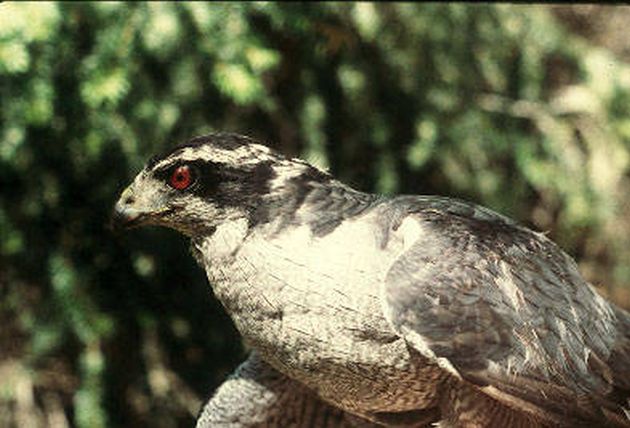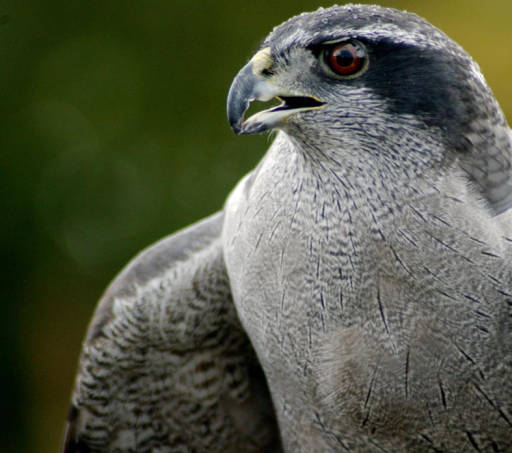
At the request of blog management, I’m embarking on a series of posts on the names of birds. Since we’ve covered some generalities already, once a month I’ll be exploring how a species, genus, or family of birds got its name, and how those names fit in with our larger understanding of, and relationship with, birds. To kick this off, I’ve decided to start with the Northern Goshawk.
First of all, it’s a gos-hawk, not a gosh-awk. Which is good. Gosh-awk would be undignified.
Some people do think the Northern Goshawk is undignified, at least compared to the falcons, as I learned while reading the excellent memoir H is for Hawk by Helen Macdonald. In this memoir, Macdonald, a falconer, writes of her relationship with a Northern Goshawk in the aftermath of her father’s sudden death, and in so doing recounts much history and lore related to flying Goshawks in Britain. Falconry may be controversial – and for good reason – with birders, but some knowledge of it is necessary to explain how the Northern Goshawk (and many of our other hawks and falcons) got its name.
Goshawk, you see, is from Gosheafoc, Old English for Goose Hawk. And yet, as an accipiter, the Northern Goshawk is not a waterfowl specialist – it will take a tree-nesting duck if it finds one, but dines mainly on various grouse, crows, hares, and the like. Instead, the name comes from the fact that in falconry, the Goshawk could be used for large prey – geese, yes, and also pheasants, hares, and cranes.
Though they are now prized, in olden times Northern Goshawks were apparently a bit declasse, a bird for antisocial, practical types who were interested in meat for the kitchen more than in trophies and status, yeomen who had to fly their birds in the woods rather than on the wide grassy pheasant parks that the nobility could afford for their falcons. So great was the social divide that in those days falconers meant strictly those who flew falcons, while those who flew anything not a falcon – back then primarily goshawks and sparrowhawks (also accipiters and not to be confused with the American Kestrel, a falcon sometimes referred to as a sparrowhawk) – were called austringers. Austringers were doofuses and the cool falconry kids did not want to associate with them – at least in Britain, where flying eagles was not a done thing until the nineteenth century. No one calls you a doofus when you have a Golden Eagle at the ready to eat their face.
Apparently not sufficiently face-eating, and yet…
Goshawks themselves had a reputation as testy, ill-tempered birds – “one cannot feel for a goshawk the same respect and admiration that one does for a peregrine”, Macdonald quotes from a falconry historian writing in 1936. As Macdonald herself amply proves, this is classic projection, another case of the human seeing in the nonhuman only what we want to see. Language as a tool for projection is, I expect, a theme that will crop up again and again in this series.
As a brief aside, the Northern Goshawk is only a cousin at the family level of the Dark Chanting Goshawk, which bids fair for one of my favorite bird names ever.
Images courtesy of the US Fish and Wildlife Service.












My favorite bird name of all is the Carbonated Sierra Finch that Edward Dickinson calls a fizzy fellow.
I’m all in favor of rationalizing English names, but I still miss the old progression sparrowhawk – pigeon hawk – duck hawk – goshawk – gyrfalcon.
“the cool falconry kids” OOOH I’m going to love this series!!
Here in Germany at least, Goshawks are frequently seen at wetlands trying to get a duck snack. I’ve never seen one go after a goose, and think that this is something that only large and experienced females would do in the wild.
And I really don’t mean to pressure you, but this first post of the series was so cool (no eagle needed) that I can’t wait for the next one!
Any bird with ‘carbonated’ in the name is bound to pop up in these discussions…
But then someone throws grasshopper hawk into the mix and screws everything up!
Thanks!
Speaking of Germany, when I stuck Goshawk into Google translate for German I got something that appeared to break out to “chicken hawk”. Does that sound right to you?
The Goshawk is called Habicht in German, which has no direct meaning, and I don’t know where it comes from. However, the “Habicht” used to be called Hühnerhabicht (“chicken habicht”), but that’s been out of fashion for many decades. I remember my grandparents using Hühnerhabicht when I was a little boy, and even back then it sounded strange and old-fashioned. “Chicken Habicht” is one of those bird names that were dropped when the hunting/extermination of certain bird species became outlawed and socially unaccepted back in the 1970, just like the “fish heron” became the “grey heron”.
But then of course, your Northern Goshawk is an entirely different species than my Northern Goshawk. Everybody seems to know that a split is long overdue, but somehow it still hasn’t happened.
Look:
http://www.ornitho.de/index.php?m_id=54&mid=146926&langu=en
That duck is certainly not tree-nesting.